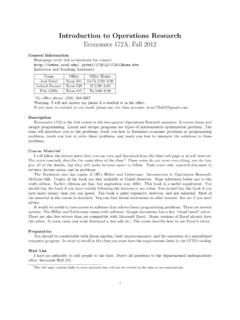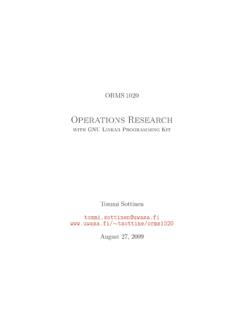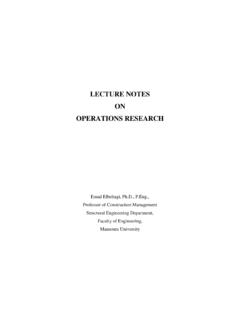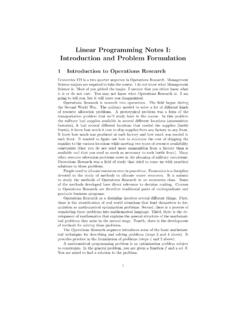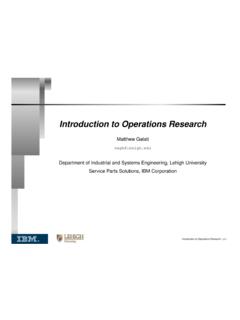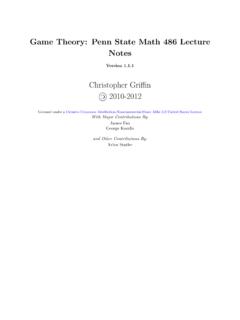Transcription of Advanced Operations Research Techniques IE316 …
1 Advanced Operations Research Techniques IE316 . lecture 7. Dr. Ted Ralphs IE316 lecture 7 1. Reading for This lecture Bertsimas IE316 lecture 7 2. The Simplex Method A typical iteration of the simplex method: 1. Start with a specified basis matrix B and a corresponding BFS x0. 2. Compute the reduced cost vector c . If c 0, then x0 is optimal. 3. Otherwise, choose j for which c j < 0. 4. Compute u = B 1Aj . If u 0, then = and the LP is unbounded. x0B(i). 5. Otherwise, = min{i|ui>0} ui . x0B(l).. 6. Choose l such that = ul and form a new basis matrix, replacing AB(l) with Aj . 7. The values of the new basic variables are x1j = and x1B(i) = xB(i). 0. ui if i =. 6 l. IE316 lecture 7 3. Some notes on the Simplex Method We will see later how to construct an initial basic feasible solution. We saw last time that each iteration of the simplex methods ends with a new basic feasible solution.
2 This is all we need to prove the following result: Theorem 1. Consider a linear program over a nonempty polyhedron P and assume every basic feasible solution is nondegenerate. Then the simplex method terminates after a finite number of iterations in one of the following two conditions: We obtain an optimal basis and a corresponding optimal basic feasible solution. We obtain a vector d Rn such that Ad = 0, d 0, and cT d < 0, and the LP is unbounded. IE316 lecture 7 4. Pivot Selection The process of removing one variable and replacing from the basis and replacing it with another is called pivoting. We have the freedom to choose the entering variable from among a list of candidates. How do we make this choice? The reduced cost tells us the cost in the objective function for each unit of change in the given variable. Intuitively, cj is the cost for the change in the variable itself and cTB B 1Aj is the cost of the compensating change in the other variables.
3 This leads to the following possible rules: Choose the column with the most negative reduced cost. Choose the column for which | . cj | is largest. IE316 lecture 7 5. Other Pivoting Rules In practice, sophisticated pivoting rules are used. Most try to estimate the change in the objective function resulting from a particular choice of pivot. For large problems, we may not want to compute all the reduced costs. Remember that all we require is some variable with negative reduced cost. It is not necessary to calculate all of them. There are schemes that calculate only a small subset of the reduced costs each iteration. IE316 lecture 7 6. Simplex for Degenerate Problems If the current BFS is degenerate, then the step size might be limited to zero (why?). This means that the next feasible solution is the same as the last. We can still form a new basis, however, as before.
4 Even if the step-size is positive, we might end up with one or more basic variables at level zero. In this case, we have to decide arbitrarily which variable to remove from the basis. The new solution will be degenerate. Degeneracy can cause cycling, a condition in which the same feasible solution is reached more than once. If the algorithm doesn't terminate, then it must cycle. IE316 lecture 7 7. Anticycling and Bland's Rule Bland's pivoting rule: The entering variable is the one with the smallest subscript among those whose reduced costs are negative. The leaving variable is the one with the smallest subscript among those that are eligible to leave the basis. Bland's rule guarantees that cycling cannot occur. We also don't need to compute all the reduced costs. IE316 lecture 7 8. Implementing the Simplex Method Naive Implementation 1.
5 Start with a basic feasible solution x with indices B(1), .. , B(m). corresponding to the current basic variables. 2. Form the basis matrix B and compute pT = cTB B 1 by solving pT B = cTB . 3. Compute the reduced costs by the formula c j = cj pT Aj . If c 0, then x is optimal. 4. Select the entering variable j and obtain u = B 1Aj by solving the system Bu = Aj . If u 0, the LP is unbounded. x B(i). 5. Determine the step size = min{i|ui>0} ui . 6. Determine the new solution and the leaving variable i. 7. Replace i with j in the list of basic variables. 8. Go to Step 1. IE316 lecture 7 9. Calculating the Basis Inverse Note that most of the effort in each iteration of the Simplex algorithm is spent solving the systems pT B = cTB. Bu = Aj If we knew B 1, we could solve both of these systems. Calculating B 1 quickly and accurately is the biggest challenge of implementing the simplex algorithm.
6 The full details of how to do this are beyond the scope of this course. We will take a cursory look at these issues in the rest of the chapter. IE316 lecture 7 10. Efficiency of the Simplex Method To judge efficiency, we calculate the number of arithmetic Operations it takes to perform the algorithm. To solve a system of m equations and m unknowns, it takes on the order of m3 Operations , denoted O(m3). To take the inner product of two n-dimensional vectors takes O(n). Operations (n multiplications and n additions). Hence, each iteration of the naive implementation of the Simplex method takes O(m3 + mn) iterations. We'll try to improve up on this. IE316 lecture 7 11. Improving the Efficiency of Simplex Again, the matrix B 1 plays a central role in the simplex method. If we had B 1 available at the beginning of each iteration, we could easily compute everything we need.
7 Recall that B changes in only one column during each iteration. How does B 1 change? It may change a lot, but we can update it instead of recomputing it. IE316 lecture 7 12. Way Back in Linear Algebra Recall from linear algebra how to invert a matrix by hand. We use elementary row Operations . An elementary row operation is adding a multiple of a row to the same or another row. To invert a matrix, we use elementary row operation to change the matrix into the identity. We then apply the same Operations to the identity to change it into the matrix inverse. We can use the same trick to update B 1. IE316 lecture 7 13. Updating the Basis Inverse We have B 1B = I, so that B 1AB(i) is the ith unit vector ei. is the new one, then If B is the old basis and B.. B 1B = [e1 el 1 u el+1 em].. 1 u1.. = ul .. um 1. We want to turn this matrix into I using elementary row Operations .
8 1. If we apply these same row Operations to B 1, we will turn it into B. IE316 lecture 7 14. Representing Elementary Row Operations Performing an elementary row operation is the same as left-multiplying by a specially constructed matrix. To multiply the jth row by and add it to the ith row, take I and change the (i, j)th entry to . A sequence of row Operations can similarly be represented as a matrix. 1 by left-multiplying by a matrix Q. Hence, we can change B 1 into B. which looks like . 1 uu1. l .. 1 . Q= ul .. uum 1. l IE316 lecture 7 15. The Revised Simplex Method A typical iteration of the revised simplex method: and the associated basis inverse B 1. 1. Start with a specified BFS x 2. Compute pT = cTB B 1 and the reduced costs c j = cj pT Aj . 3. If c 0, then the current solution is optimal. 4. Select the entering variable j and compute u = B 1Aj.
9 5. If u 0, then the LP is unbounded. B(i). x 6. Determine the step size = min{i|ui>0} ui . 7. Determine the new solution and the leaving variable i. 8. Update B 1. 9. Go to Step 1. IE316 lecture 7 16. The Tableau Method This is the standard method for solving LPs by hand. We update the matrix B 1[b|A] instead of just B 1. In addition, we also keep track of the reduced costs in row zero . This method is more expensive than revised simplex and is just for illustration. The method of updating the matrix is the same as in revised simplex. IE316 lecture 7 17. What the Tableau Looks Like The tableau looks like this cTB B 1b cT cTB B 1A. B 1b B 1A. In more detail, this is T. cB xB c 1 c n xB(1).. B 1A1 B 1An xB(m). IE316 lecture 7 18. Implementing the Tableau Method 1. Start with the tableau associated with a specified BFS and associated basis B.
10 2. Examine the reduced costs in row zero and select a pivot column with c j < 0 if there is one. Otherwise, the current BFS is optimal. 3. Consider u = B 1Aj , the jth column of the tableau. If no component of u is positive, then the LP is unbounded. 4. Otherwise, compute the step size using the minimum ratio rule and determine the pivot row. 5. Scale the pivot row so that the pivot element becomes one. 6. Add a constant multiple of the pivot row to each other row of the tableau so that all other elements of the pivot column become zero. 7. Go to Step 2.
